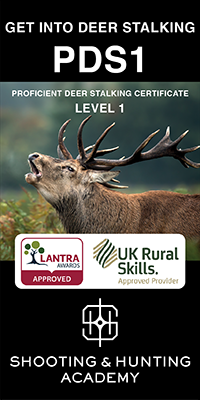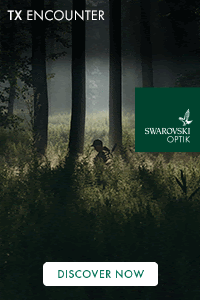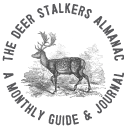
What to expect from your Deer Stalking month by month. Enter your email address below to receive the Almanac:
Roe Buck Stalking
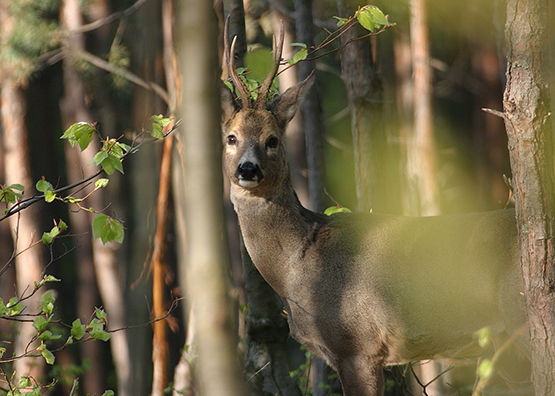
Roe Buck stalking offers some of the most exhilirating and exciting deer stalking in the world and can be at its very best in the South of England where numerous medal class animals are acheived on a yearly basis.
At County Deer Stalking we are able to offer first class stalking for Roe Buck during the whole of the season which stretches from 1st April to 31st October.
During the whole of the summer (Particularly from May - early August) bucks can be seen jostling for territory, however the season is at its most thrilling during the rut in late July and early August when Roe Buck throw caution to the wind in their attempt to mate.
It is during the rut that Roe buck can also be seen to come to a well executed call, something which when witnessed can be a truly memorable experience!
(To watch our short film in which we demonstrate Roe Calling, follow this link: youtube)
Our Roe Buck stalking is in beautiful countryside locations within the county of Hampshire, a county well reputed as having some of the very best Roe Buck.
Within our cull plan we have many quality medal class animals and can offer superb stalking for both the serious trophy hunter or those who simply wish to be able to continue their stalking throughout the summer months.
The grounds are less than one hour from London Heathrow and Gatwick Airports and are easily accessible from both the M3 and M4 motorways.
We can also offer assistance with transport and advice on accomodation as required.
Roe Buck stalking is highly prized and as such we do not class these deer as 'cull animals'. For details of our pricing for Roe Buck please take a look at our: terms-conditions
If you like to watch a film about stalking Roe Buck in May take a look at our short films page: short-films (Roe Buck in May -2014)
ROE BUCK Open Season in England & Wales: 1st Apr - 31st October
To book an outing or for more details please CONTACT US.
Back to Overview
Fallow Deer Stalking
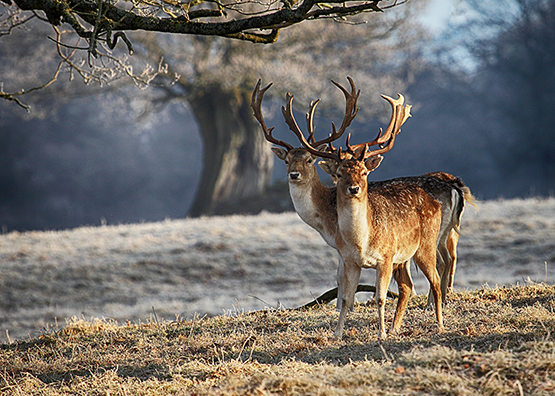
Fallow Deer Stalking - At County Deer Stalking we are able to offer Fallow Deer Stalking over a number of beautiful private estates in the South East of England less than one hour from London.
We are able to offer first class stalking of both cull animals and superb Fallow Buck Trophies. (Please contact us for more details).
The season for Fallow Buck stretches from 1st August until the 30th April and for Fallow Does from the 1st November until the 31st March.
Fallow Deer (Dama dama) are a herding deer and have been gracing our countryside for hundreds of years, having first been introduced by the Normans. For many years they were associated with wealth and their presence in the private grounds of many Country Estates was seen as a status symbol.
Today the south east of England plays host to large numbers of wild Fallow deer, who now roam free around areas were once they were introduced.
Here at County Deer Stalking our fallow deer stalking is over the grounds of a number of former Country Estates, however the Fallow today are completely wild and free ranging.
The Fallow seen on the Estates, vary in appearance and include the four colour variations Menil, Common, White and Melanistic (black). The Fallow Rut usually takes place around October and can be an exciting time when the bucks take up 'Rutting Stands' and can be heard by their characteristic 'groaning' and 'belching'.
Although the predominant species on these estates are Fallow deer, they are also frequented by occassional Roe deer and Muntjac deer.
To find out more about Fallow Deer and to watch us stalk this species taek a look and some of our short-films.
| FALLOW DEER Open Season in England & Wales | |
| Bucks | 1st Aug - 30th April |
| Does | 1st Nov - 31st March |
If you are interested in Fallow Deer Stalking please CONTACT US for more details.
Back to Overview
Roe Deer Stalking
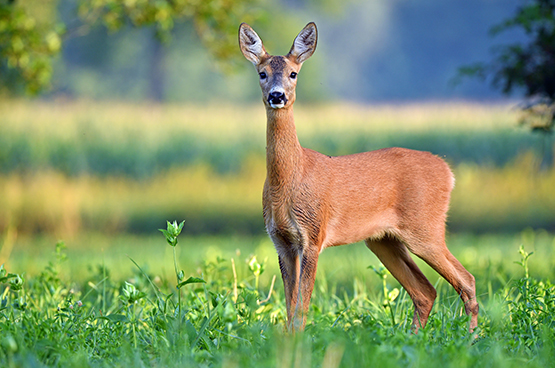
Roe Deer Stalking - The South East of England offers some of the very best Roe deer stalking in the world.
At County Deer Stalking we are delighted to be able to offer all year round stalking of this elegant deer at our attractive stalking grounds in Hampshire, less than one hour from London and easily accessible via either the M3 or M4 corridors.
Roe deer (Capreolus Capreolus) are a long legged and secretive deer and are native to the UK. They are usually found alone or in small groups and for many deer stalkers represent the very best in UK stalking.
The Roe Buck season stretches from the 1st April to the 31st October and the Roe Doe season from 1st November until the 31st March. This means that we are able to stalk one or other of the sexes all year round.
For much of the year both sexes are territorial, however this activity peaks around late July and early August during the Rut, when the Buck chases the Doe, usually in circles or a figure of eight, until such time as mating takes place.
Roe Buck are unique in UK deer in so much as antler growth takes place during January to March. The result is that the stalking season for Bucks is over the summer months when the bucks are in hard antler.
At County Deer Stalking we have a good range of trophy Roe Buck and less dominant Roe Buck during the summer, along with a sizeable Doe cull to undertake during the winter months.
To watch us stalking Winter Roe Deer and for more information about the stalking of Roe Does, take a look at our short films page: short-films (February 2014)
| ROE DEER Open Season in England & Wales | |
| Bucks | 1st Apr - 31st October |
| Does | 1st Nov - 31st March |
If you are interested in stalking Roe Deer then please CONTACT US for more details.
Back to Overview
Muntjac Deer Stalking
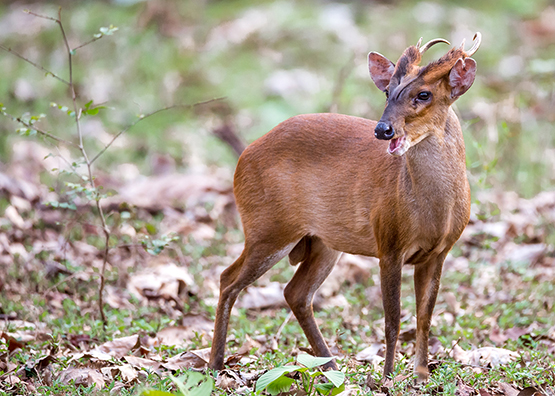
The Indian Sub species of Muntjac was first introduced into the UK at Woburn Abbey, Bedfordshire in 1893 by the Duke of Bedford, before subsequently being replaced by the secretive and diminutive little 'Reeves Muntjac'.
After several deliberate releases and many escapes the 'Reeves Muntjac' has now colonised much of southern England. There expansion and ever increasing numbers, can in part be put down to the fact that they are the only deer species in the UK to be able to breed all year round, with does being able to give birth every 7 months!
Notable for having visible canine tusks and typically weighing only around 10- 20kg on the hoof they are one of the UK's smallest and most primitive deer species.
Muntjac make for some challenging and exciting deer stalking, which often involves stalking through thick cover and dense woodland. At County Deer Stalking we have good numbers of Muntjac and due to there being no closed season we are able to offer Muntjac deer stalking all year round at our Estates in Hampshire and Oxfordshire.
In addition to Muntjac we also have good numbers of Roe and Fallow Deer.
| MUNTJAC DEER Open Season | |
| Bucks | No Close Season |
| Does | No Close Season |
If you are interested in stalking Muntjac Deer or one of our other species then please CONTACT US for more details.
Back to Overview
Deer Species: Red Deer
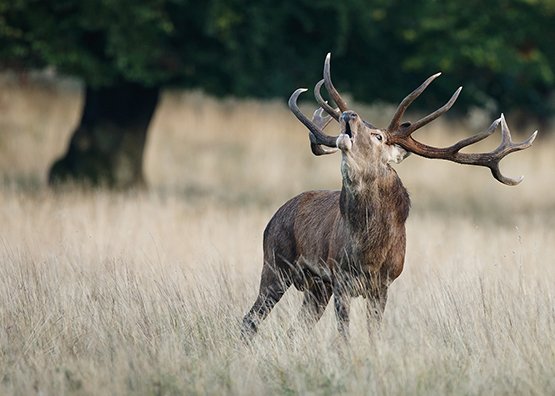
Possibly the most familiar of all UK Deer due to its appearance in many parks the native Red Deer (Cervus elaphus) is our largest species of deer growing up to 115cm at the shoulder and up to 250kg in weight.
Most people will have seen images of the classic twelve pointed antlers of a "Royal" stag and be aware of its characteristic "bellow".
Although traditionally thought of as purely a Scottish Deer, herds can also be found in Exmoor whilst a few examples can also be found in counties elsewhere in the UK due to accidental escapes from Parks.
Red Deer spend most of the year in single sex herds however in September the Stags become increasingly aggressive to one another after which the 'break out' takes place, it is at this stage that both Hind and Stag herds come together for the rut which takes place at the end of September and continues until the end of October. The stag typically rounds up a number of Hinds which he then aims to defend against other stags.
Hinds will have single calves around May and June however in highland areas not all Hinds will be sufficiently well nourished to have calves every year. These barren hinds are called 'yelds'.
Antler casting by the Stags is in late March - May with the velvet being shed by late August - September.




